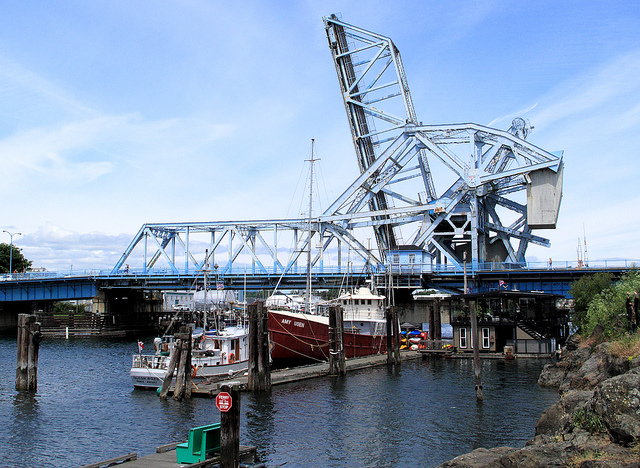
Does this story sound familiar?
An aging bridge in a region where earthquakes are common is in need of major repair. In an attempt to save money, government officials opt to hire a company based in China to produce the steel needed for the bridge. But the steel that the China-based company produces is of poor quality, potentially delaying the project.
The saga certainly sounds like that of the San Francisco-Oakland Bay Bridge, which continues to face significant problems due to the steel used to build it.
But the story above is that of a different bridge. And this one isn’t even in the United States.
The Johnson Street Bridge is a bascule bridge in Victoria, British Columbia, Canada. Often called “the blue bridge” by locals because of its color, the bridge spans the city’s harbor and connects downtown with the historic neighborhood called Victoria West. Although it’s a local landmark, the 90-year-old bridge is aging and in need of serious rehabilitation, especially considering Victoria is located in the most seismically active part of Canada.
In 2010, the city council opted to replace the bridge and voters approved a referendum to borrow $49.2 million to build it. But just like what happened with the Bay Bridge, the decision to use steel produced overseas by a company based in China has put the Johnson Street Bridge at serious risk.
The steel for the bridge is being produced in India by Chinese company Jiangsu Zhongtai Steel Structure Company. The Times Colonist reports that steel fabrication is being halted after "inspections found it was not being built according to design.” Turns out the lifting lugs that are needed to move the bridge weren’t fabricated correctly — and the problem is so bad that the steel might have to be scrapped and the process started from scratch.
The Canadian Ironworkers Union said Victoria officials could have saved time and money if they had opted to use domestic steel rather than steel produced overseas.
As with the Bay Bridge, the Johnson Street Bridge has faced cost overruns and delays. It is now expected to cost more than $100 million and open in January 2016, several months behind schedule.
Sigh.
As with the Bay Bridge, there are lessons to be learned from the Johnson Street Bridge. Trying to take the cheap route doesn’t work — it leads to problems and cost overruns.
It doesn’t have to be this way, of course. The Tappan Zee Bridge in New York is being built with U.S. steel, creating more than 7,700 jobs and generating billions of dollars in revenue, for example. Going with a U.S. company is expected to save more than $1.5 billion and more than two years in construction time than original estimates.
